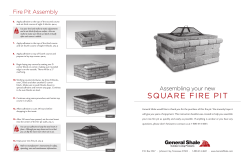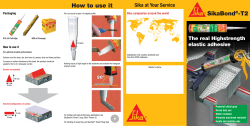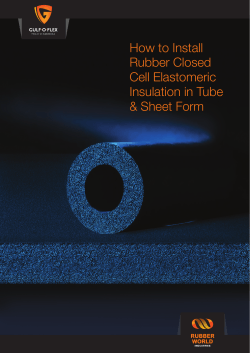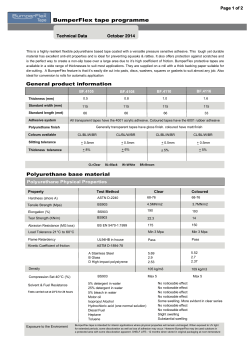
APPROXIMATE METHOD TO EVALUATE THE FRACTURE TOUGHNESS
Proceedings of the 26th Annual meeting of the Adhesion Society Myrtle Beach, USA, 23-26 february 2003, p. 304-306 APPROXIMATE METHOD TO EVALUATE THE FRACTURE TOUGHNESS OF INTERFACES BETWEEN SOFT VISCO-ELASTIC LAYERS AND WEAKLY ADHERING SURFACES Gwendal Josse, Philippe Sergot and Costantino Creton Laboratoire de Physico-Chimie Structurale et Macromoléculaire E.S.P.C.I. 10, Rue Vauquelin, 75231 Paris Cédex 05 Email: Costantino.Creton@espci.fr It is the purpose of this paper to propose a method to quantify the energy dissipated during lateral crack propagation and to separate it from the energy necessary to form fibrils. Introduction The quantification of the level of adhesion of a soft viscoelastic layer in contact with a rigid surface is a difficult problem. It is well know that this type of adhesives is highly deformable and can form bridging fibrils between two surfaces[1]. The work expended in deforming these fibrils is of course part of a macroscopic measurement of the peel force for example. However it is unlikely that the stress level at which the fibrils extend and their maximum extension are much dependent on the interface. Observation of the peel front and of PSA detachment from a flat probe[2,3] have shown however that the formation of fibrils starts with the nucleation of cavities (or the formation of fingers), which break the confinement of the adhesive layer and allow the uniaxial extension of the fibrils. If this process of reducing locally the confinement occurs by the propagation of cavities of fingers at the interface between the adhesive and the adherent, one expects this stage to be interface sensitive. An example of lateral growth of cavities is shown on figure 1. This growth of cavities occurs because the layer, which was previously stressed, releases its stored elastic energy and this energy is chiefly released by the propagation of interfacial cracks. Experimental The adhesive used was an acrylic commercial pressuresensitive-adhesive provided by Rhodia, polymerized by emulsion polymerization. An excess amount of latex was deposited on a standard microscope glass slide and doctor bladed in order to obtain a final thickness of 100 µm in the dry film. The wet layer was then slowly dried at room temperature, first in air then in vacuum. The rheological properties of the adhesive in the dry state were characterized with a parallel plate rheometer and the relaxation modulus of the adhesive G(t) at 20°C is given in figure 2. 2 4 G (Pa) 10 9 8 7 6 5 4 3 2 0.1 1 10 100 1000 t (s) Figure 2: Relaxation shear modulus G as a function of time for the acrylic adhesive. The solid line represents data taken at 5% strain while the circles have been taken at 80% strain. No obvious non linear behavior is observed in that range. Figure 1: Images of the detachment of an adhesive layer from polished steel. Left at the maximum tensile force: Two seconds later when the force has dropped by 50%. The flat surface of the cylindrical probe was coated with a 1 µm thick layer of a three component curable commercial silicone elastomer which was provided by Rhodia. The specific silicone formulation was chosen as a model low adhesion material for the purpose of developing the method. It was a simple crosslinked PDMS elastomer with no additional additive but with a distribution of the molecular weight of the chains between crosslinking points. A specific example of such a situation is the adhesion between a PSA and a release coating but any repositionable PSA on a steel surface (as the example of figure 1 shows) will exhibit the same mechanism. 1 The material chosen was almost perfectly elastic with an elastic modulus E' = 0.8 MPa, frequency independent at room temperature. After deposition of the three components solution by spin-coating, the probe was cured in order to obtain an optimum degree of crosslinking but was not extracted after curing. A 2-3% fraction of soluble fraction was therefore still present in the layer after curing. This procedure was chosen to work with a material as close as possible to the situation encountered in practice. The bare surface of the probe was simply a polished stainless steel surface, cleaned with a degreasing agent. The experimental apparatus was a custom developed probe tack tester, able to record simultaneously and independently the adhesive displacement (distance between the probe and the glass substrate), the position of the driving motors, the force and the video image of the debonding through the glass slide. The compliance of the instrument used in these tests, which plays an important role is of 3 µm/N corresponding to 3.3x105 N/m. Unlike traditional tack tests (where after the probe is pushed in contact with the PSA, it is removed a constant speed) in our case, the probe was pulled and then the driving motors were stopped at a specific preset point where the adhesive was kept under tensile stress. The driving motors being stopped, the system was able to evolve by itself to a minimum in potential energy. This evolution meant a release of elastic energy (stored in the layer and in the compliant machine) and a growth of interfacial cracks as shown on figure 1. By stopping the test at different levels of stored elastic energy, we have measured the decrease in force with time and the evolution of the contact area with video images. gime, the compliance of the apparatus is significantly larger than the compliance of the layer, decreasing further the role the viscoelasticity of the layer might play. In figure 3 for example the compliance of the adhesive layer is 0.75 µm/N, a factor of four inferior to that of the apparatus. The second effect is the confinement of the layer which severely restricts flow since the compressibility modulus of the adhesive is not very rate dependent. In the following experiments, we have performed a series of debonding tests with the same probe and on the same adhesive by stopping the test at progressively higher values of the tensile force. The debonding speed before the stop was fixed at 10 µm/s. and the compressive force to establish the contact was fixed at 20 N. The position of the motors was kept constant for 5 seconds. As one can see from figure 4, the rate at which the force relaxes to zero greatly depends on the level of force attained before the drive stops. At low level of imposed force, the relaxation is slow while at high level of force the relaxation is fast. This is incompatible with the relaxation behavior of the adhesive in the bulk shown on figure 2. 7 6 F (N) 5 4 3 2 1 0 Results and Discussion 0 1 2 t(s) 3 4 5 25 20 Force (N) Figure 4: A series of probe tests performed with the same adhesive on a low adhesion surface. Different tests correspond to different levels of applied force before stopping the motors. The probe velocity before the stops is 10 µm/s. 1 µm/s-1 5 µm/s-1 25 µm/s-1 100 µm/s -1 15 The observation of the interface during the relaxation of the force shows that the force relaxes essentially because the adhesive debonds from the surface of the probe by the propagation of finger like cracks at the interface between the probe and the adhesive. One of these finger like cracks is shown on figure 5. Since, regardless of the level of the force at the stop point, the debonding occurs by the same mechanism, the difference in relaxation kinetics must be related to the different crack velocities. The crack velocity cannot easily be measured directly at the crack tip since it is not really identical everywhere. However what is easily done is to measure the time of debonding and assume that all the surface of the probe has detached from the surface at an average velocity within that time frame. 10 5 0 0 50 100 150 200 250 Motor displacement (µm) Figure 3: probe tests of the PEHA adhesive on a steel surface. The probe velocity is being varied from 1 to 100 µm/s. Before the test is stopped, the apparent modulus of the layer is very weakly dependent on the probe velocity as shown on figure 3. This is due to two effects: in this re- 2 surface and close to 1 for the steel surface. These exponents can be compared to the data obtained by others using the JKR method to investigate the adhesion of crosslinked elastomers on solid surfaces and are significantly higher. However one must note that these adhesives are much more viscoelastic than a crosslinked rubber and it should therefore not be surprising to find a more dissipative and rate dependent behavior at the interface. The second important point is the low absolute values obtained for the silicone surface. At the lowest propagation velocity the value of ∆Ε is only 350 mJ/m2, hardly higher than the thermodynamic value. As a comparison, peel tests performed on a very similar interface and with a viscoelastic adhesive gave a value close to 2 J/m2 at the same crack velocity[4]. Therefore this probe method maybe and intermediate experimental method, more interfacial than peel, while avoiding the difficulties in the analysis of the JKR method with viscoelastic adhesives. Figure 5: typical image of the debonding of the adhesive from the low adhesion surface. The bottom part of the probe is not in contact. In this case an average crack velocity is simply given by: πa 2 V = Conclusions ∆t We have shown that the adhesive properties of a viscoelastic PSA on a rigid surface can be evaluated quantitatively with a probe method. The confined geometry of the film before debonding combined with a relatively compliant testing apparatus, allows us to load the interface rapidly and essentially elastically, before the debonding occurs with significant viscoelastic dissipation. Since the experiment is performed at low values of displacement, no fibrillation can take place and the measured adhesion energy only reflects the interfacial component. This method may be an interesting alternative to peel tests, for low adhesion surfaces, since it can provide relatively easily the equivalent of a G vs. V curve for a specific interface. However further investigation is needed to explore the limitations of the method in the case of more viscoelastic and more adhesive systems. where a is the radius of the probe. On the other hand the elastic energy stored in the sample and in the apparatus is easily evaluated with the force distance curve, given the nearly linear elastic behavior displayed shown on figure 3. Therefore the data obtained on figure 4 can be plotted as ∆E vs. V . Such a plot is shown on figure 6 for our acrylic adhesive on two different surfaces (low adhesion and polished steel) and characterizes the adhesion between the probe and the viscoelastic adhesive in a quantitative way by measuring the level of energy dissipation as a function of crack velocity. 100 6 4 2 Acknowledgements 2 ∆E (J/m ) 10 6 4 We thank Rhodia Silicones for funding this work and we thank M. Dorget of Rhodia CRA in Aubervilliers for his active participation in this project. 2 1 6 4 References 2 0.1 2 10 10 3 4 10 10 5 6 10 [1] Zosel, A., Journal of Adhesion 30, 135-149 (1989). [2] Urahama, Y., Journal of Adhesion 31, 47-58 (1989). [3] Lakrout, H., Sergot, P., and Creton, C., Journal of Adhesion 69, 307-359 (1999). [4] Amouroux, N., Petit, J., and Léger, L., Langmuir 17, 6510-6517 (2001). V(µm/s) Figure 6: Plot of the released elastic energy (∆E) as a function of average crack velocity V during debonding. () steel. (z) As it is immediately apparent from the data in figure 6, the experimental curves can be fitted to a power-law. The exponent which best fits the data is 0.5 for the low adhesion 3
© Copyright 2025















